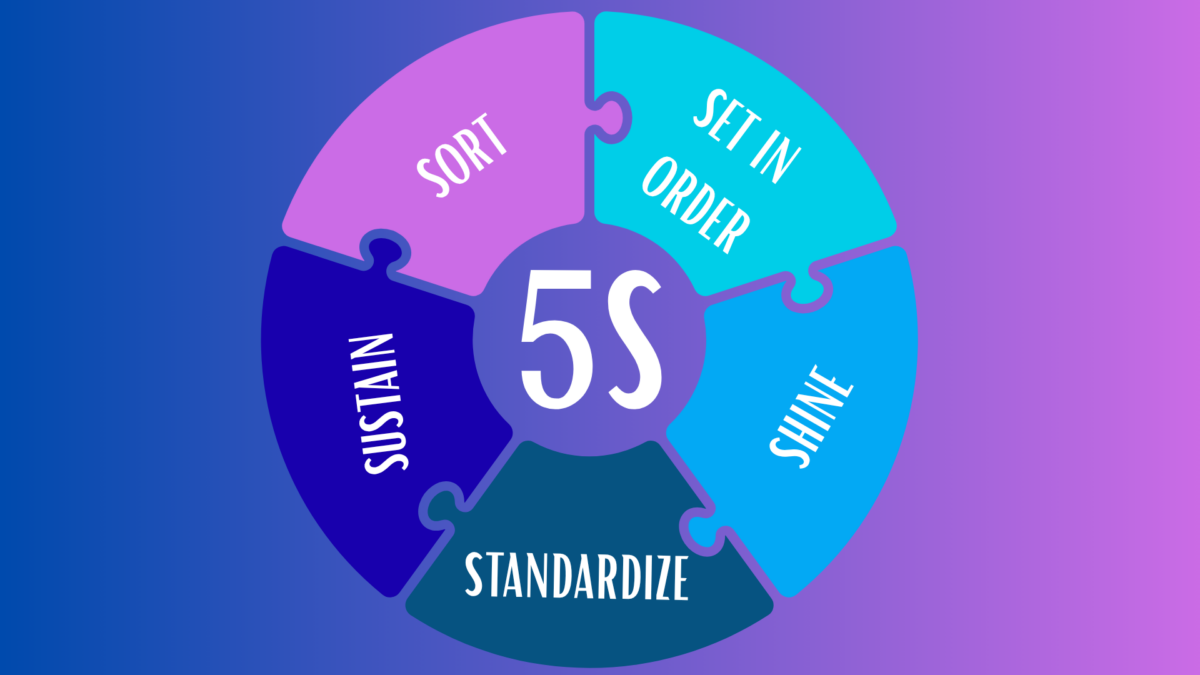Why 5S Is a Key Component of Lean Manufacturing
In the manufacturing industry, achieving operational excellence and continuous improvement requires more than just automation and advanced equipment. At its core lies the 5S Lean methodology—a five-step system drawn from the Toyota Production System by Toyota Motor Company. By adopting 5S Lean Manufacturing, organizations implement a visual workplace that systematically eliminates waste, boosts workplace efficiency, and creates a culture where teams drive ongoing improvement.
Ready to get started? Enroll in our hands-on 5S Lean Training Course and master the Toyota approach to workplace organization.
The Five Japanese Words Behind 5S Methodology
5S stands for five Japanese terms that guide your shop floor from chaos to clarity:
- Seiri (Sort): Remove unnecessary items and hazardous materials, leaving only the necessary resources.
- Seiton (Set in Order): Organize tools and materials into a visual factory layout, utilizing visual cues and shadow boards to ensure everything is easily accessible.
- Seiso (Shine): Perform basic cleaning and equipment inspections to spot wear or spills that could cause safety or quality issues.
- Seiketsu (Standardize): Develop standardized work procedures, checklists, and visual management boards so best practices become a daily habit.
- Shitsuke (Sustain): Embed self-discipline and employee engagement through regular audits, training new employees, and building participation at every level.
These steps transform your production processes into a well-organized, productive work environment.
Discover each step in depth with our comprehensive 5S Lean Training Course.
How 5S Drives Waste Reduction and Productivity
Eliminating Waste Across the Shop Floor
By sorting out remaining items and removing clutter, 5S directly tackles common forms of waste—defects, overprocessing, excess inventory, and unnecessary motion. When every tool has its place and the floors are kept clean, workers waste less time searching and more time producing.
Visual Workplace and Visual Factory
A 5S environment relies on visual communication tools—such as floor markings, color-coded bins, and labeled storage—to instantly convey the status of processes. This visual management approach ensures that abnormalities stand out, empowering team leaders and maintenance crews to act promptly.
Boosting Employee Morale and Engagement
Involving workers in the Sort and Set in Order phases builds employee buy-in. As teams see their workspace transform into a safer, more organized working environment, employee morale soars, and they take pride in maintaining order.
Learn proven techniques to create standards and sustain gains in our 5S Lean Training Course.
Implementing 5S Across Diverse Industries
- Automotive Plants: Rooted in the Toyota Production System, 5S is nearly synonymous with lean production in auto manufacturing.
- Healthcare: Hospitals use 5S to improve patient safety by organizing supplies and eliminating hazardous materials.
- Food & Beverage: Clean, properly organized kitchens and production lines reduce contamination risk and boost throughput.
- Office & Knowledge Work: Digital equivalents of 5S keep files, emails, and workstations streamlined for maximum efficiency.
Regardless of the sector, 5S remains a crucial element for eliminating waste and optimizing operational processes.
Measuring Success: Key Performance Indicators
Track these metrics to gauge your 5S journey:
- Time Searching: The Minutes workers spend locating tools before and after Sort/Set in Order.
- Audit Compliance: Percentage of audited areas meeting 5S standards.
- Defect Rate: Reduction in quality issues due to Shine and standardized work.
- Safety Incidents: Fewer near-misses and accidents thanks to hazard removal.
- Productivity Gains: Throughput improvements on production lines and the manufacturing floor.
By regularly reviewing these KPIs, you ensure that 5S is not a one-off project, but a living system that drives continuous improvement.
Tips for Sustaining 5S as a Culture
- Schedule Regular Audits: Keep momentum with weekly or monthly 5S checks.
- Rotate Champions: Empower different team leaders to own audits and training.
- Integrate with Daily Routines: Embed Shine, Standardize, and Sustain into shift-start meetings.
- Celebrate Wins: Recognize teams who maintain high 5S scores to fuel employee engagement.
- Link to Performance Reviews: Tie 5S adherence to individual and team KPIs.
With these practices, 5S Lean becomes a core part of your organization’s DNA—just a matter of how you operate every day.
Conclusion: Your 5S Lean Path Forward
Implementing 5S Lean Manufacturing offers a systematic approach to transforming your workplace into a visual factory where waste is eliminated, organization is second nature, and teams are energized. By mastering the five Japanese words and embedding them into your daily routines, you unlock the full power of lean, achieving higher productivity, reduced costs, and superior safety.
👉 Start your transformation with our 5S Lean Training Course today!

